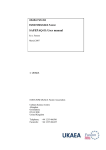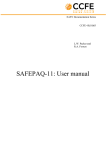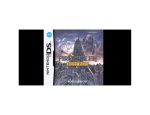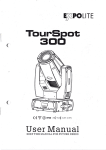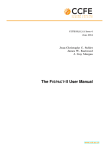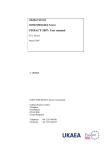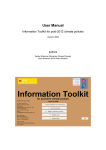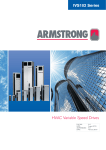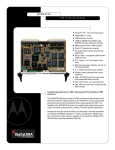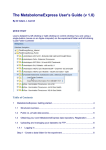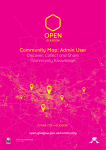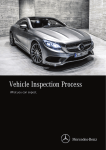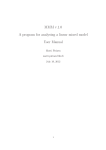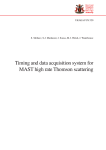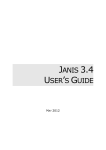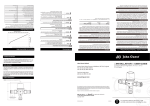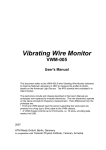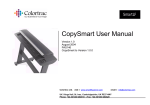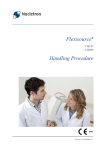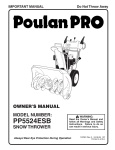Download The European Activation System: EASY
Transcript
United Kingdom Atomic Energy Authority UKAEA FUS 513 R.A. Forrest The European Activation System: EASY-2005 overview Enquiries about copyright and reproduction should in the first instance be addressed to the Culham Publications Officer, Culham Centre for Fusion Energy (CCFE), Library, Culham Science Centre, Abingdon, Oxfordshire, OX14 3DB, UK. The United Kingdom Atomic Energy Authority is the copyright holder. The European Activation System: EASY-2005 overview R.A. Forrest EURATOM/UKAEA Fusion Association, Culham Science Centre, OX14 3DB, Abingdon, UK . UKAEA FUS 513 EURATOM/UKAEA Fusion The European Activation System: EASY-2005 overview R.A. Forrest January 2005 UKAEA EURATOM/UKAEA Fusion Association Culham Science Centre Abingdon Oxfordshire OX14 3DB United Kingdom Telephone: +44 1235 466586 Facsimile: +44 1235 466435 EASY Documentation Series UKAEA FUS 513 The European Activation System: EASY-2005 overview R. A. Forrest EURATOM/UKAEA Fusion Association, Culham Science Centre, Abingdon, Oxfordshire OX14 3DB, UK Contents Introduction ...............................................................................................1 The EASY documentation set ...................................................................2 FISPACT-2005 ..........................................................................................3 Description............................................................................................................... 3 Specification ............................................................................................................ 4 EAF-2005 ...................................................................................................8 EAF_XS-2005 .......................................................................................................... 8 EAF_GXS-2005 ....................................................................................................... 9 EAF_UN-2005 ......................................................................................................... 9 EAF_DEC-2005....................................................................................................... 9 EAF_FIS-2005 ......................................................................................................... 9 EAF_HAZ-2005....................................................................................................... 9 EAF_A2-2005 ........................................................................................................ 10 EAF_CLEAR-2005 ............................................................................................... 10 EAF_STOP-2005................................................................................................... 10 EAF_SPEC-2005 ................................................................................................... 11 EAF_XN-2005 ....................................................................................................... 11 EAF_ABS-2005 ..................................................................................................... 11 EASY User Interface ...............................................................................11 SAFEPAQ-II............................................................................................13 Organising data..................................................................................................... 14 Viewing data.......................................................................................................... 14 Altering data.......................................................................................................... 15 Processing data...................................................................................................... 15 Logging changes .................................................................................................... 15 Availability ...............................................................................................19 Terms of use........................................................................................................... 19 Computer platforms ............................................................................................. 19 References ................................................................................................20 Acknowledgements ..................................................................................21 Disclaimer ................................................................................................21 Contact person .........................................................................................21 EASY 1 Introduction This document gives an overview of the European Activation System (EASY) as released in 2005. EASY-2005 consists of a wide range of codes, data and documentation all aimed at satisfying the objective of calculating the response of materials irradiated in a neutron flux. The main difference from the previous version is the upper energy limit which has increased from 20 to 60 MeV. It is designed to investigate both fusion devices and accelerator based materials test facilities that will act as intense sources of high energy neutrons causing significant activation of the surrounding materials. The very general nature of the calculational method and the data libraries means that it is applicable (with some reservations) to all situations (e.g. fission reactors or neutron sources) where materials are exposed to neutrons below 60 MeV. EASY can be divided into two parts: data and code development tools and user tools and data. The former are required to develop the latter, but EASY users only need to be able to use the inventory code FISPACT and be aware of the contents of the EAF library (the data source). The extensive documentation set for EASY is described in detail below. The generation of the European Activation File (EAF) is carried out using the SAFEPAQ-II application that is based on the SYMPAL and SAFEPAQ code systems. SAFEPAQ-II uses as input many world-wide sources of nuclear data. These evaluated files, calculations and experimental data are used to construct a collection of cross section data for neutron-induced reactions on a large set of stable and unstable target nuclides, a decay data file and other data libraries required by FISPACT. This overview will describe the complete EASY documentation set, describe briefly the FISPACT-2005 inventory code, the contents of the EAF library, the EASY User Interface, the SAFEPAQ-II tool and give the quality assurance (QA) procedures under which all development work is conducted. In addition the availability of EASY is discussed - both the computer platforms on which it is available and the conditions for its use. Users are recommended to investigate the available documentation and become familiar with the FISPACT code and the EAF libraries. The FISPACT User manual contains many examples showing the capabilities of the code, and although it is easy to run inventory calculations without studying the manual, users who do this will miss many of the advanced features which will simplify and enhance their inventory calculations. Overview: Issue 1, December 2004 UKAEA Fusion EASY 2 The EASY documentation set Documentation of the various parts of EASY is achieved mainly by a series of UKAEA reports. The reports are also available in ‘Portable Document Format’ (PDF) on the CD ROM used to distribute EASY, and so can be viewed on-line. The reports and other relevant information are given the identifiers EDS-1 to EDS-4 (note that the current document, EDS-0, completes the set). A complete hard-copy of the documentation is supplied to commercial users of EASY, but UKAEA will not supply EDS-2 to other users. A discussion of the different types of licence available to potential users is given in the Availability section. The components of the EASY documentation set are given in Table 1. Table 1. Parts of the EASY Documentation Series. EDS Report EDS-0 EDS-1 EDS-2 EDS-3 EDS-4 Title EASY-2005: Overview FISPACT-2005: User manual FISPACT-2005: Qualification report EAF-2005: Data libraries EASY-2005: Processing system Some EDS parts are subdivided into various separate reports; these are detailed in Table 2. The component shown in italics has not been released as a UKAEA report. Full details of the UKAEA reports are given in the references shown in the third column. Note that all UKAEA reports are widely distributed to libraries and are available on request. Table 2. The composition of the EASY Documentation Series. Report EDS-0 EDS-1 EDS-2 EDS-3 EDS-4 UKAEA report number EASY-2005:Overview FISPACT-2005: User manual Selection of reports and papers EAF-2005: Cross section library EAF-2005: Decay data library EAF-2005: Biological, clearance and transport libraries SAFEPAQ-II: User manual SYMPAL: User guide† SYMPAL: Utilities guide† SAFEPAQ: User manual† Ref. 1 2 3 4 5 6 7 8 † These processing reports have not been updated for EAF-2005, but are shown for reference purposes. UKAEA Fusion Overview: Issue 1, December 2004 EASY 3 FISPACT-2005 Description FISPACT is an inventory code that has been developed for neutron-induced activation calculations for materials in fusion devices. The current version is FISPACT-2005, which is the culmination of nineteen years of development. It uses external libraries of nuclear data for all relevant nuclides to calculate the number of atoms of each species at a specified time during the irradiation or after a decay time following shutdown. The various species are formed either by a direct reaction on a starting material, by a series of reactions some of which can be on radioactive targets or by a decay or series of decays. The accuracy of the calculated inventory is dependent on the quality of the input nuclear data - the cross sections and decay properties - the European Activation File (EAF), described in the next section, is the recommended source of data. FISPACT is used by preparing an INPUT file that uses a series of code words to describe the materials, the irradiation conditions, the various decay times and which of the many options (type of output and calculational parameters) are required. An OUTPUT file is always produced which contains information on each time interval in a compact but easily understandable format. In order to specify the location of all the data files on the local system that must be available to the code, the file FILES is always required to be connected to stream 4. Figure 1 shows these files in a diagrammatic form. INPUT FILES FISPACT OUTPUT Figure 1. Overview of files used by FISPACT. The main items of information that must be supplied by the user are: Overview: Issue 1, December 2004 UKAEA Fusion EASY 4 • Composition and mass of the material to be irradiated, either as the percentage elemental composition (in which case FISPACT will use natural abundances to calculate the number of atoms of each nuclide) or explicitly as the number of atoms of each nuclide. • Description of the neutron spectrum either using one of the built-in energy group structures (69, 100, 172, 175, 211, 315 and 351 groups) or for any other group structure also to supply the group boundary energies so FISPACT can convert to one of the seven standard structures. • Details of the irradiation (total neutron flux and time) which may be either continuous or in a series of pulses and, for the period following shutdown, a series of decay times at which inventories are required. • The type of run required - whether library data are processed or inventories calculated and, in the latter case, if uncertainties, pathways, sensitivities, graphs, fission of actinides or sequential charged particle reactions are to be considered. The many options available and the description of the code words used in the INPUT file are fully explained in the FISPACT-2005 User manual [1]. This contains many examples of input, which illustrate how the user can construct input for any particular type of run. Specification The functional specification of FISPACT-2005 is given below. UKAEA Fusion 1. FISPACT uses external libraries of cross sections and decay data to calculate the inventory of nuclides following irradiation and at various decay times. 2. Neutron-induced cross section data must be available in the EAF format (modified ENDF/B-6) in a standard energy group structure. The standard structures are WIMS (69), GAM-II (100), XMAS (172), VITAMIN-J (175), VITAMIN-J+ (211), TRIPOLI (315) and TRIPOLI+ (351). 3. For every nuclide appearing as the parent or daughter in the cross section library and for all decay products of these nuclides there must exist an entry in the decay data library (in ENDF/B-5 or -6 formats). 4. A neutron spectrum should be available in one of the standard energy structures. If this is not possible then the energies of the particular group boundaries must be Overview: Issue 1, December 2004 EASY 5 supplied so that FISPACT can convert the spectrum to one of the standard structures. 5. FISPACT can model an arbitrary irradiation, for example one that is either continuous or consists of a series of pulses. 6. FISPACT will handle any nuclides for the elements hydrogen (Z=1) to fermium (Z=100). Note that the nuclide 48 Fe is used internally by FISPACT and so cannot be considered in calculations. 7. The light nuclides (1H, 2H, 3H, 3He and 4He) which are produced from reactions such as (n,p), (n,d), (n,t), (n,h) and (n,α) and by α decays are included in the inventories, in addition to their formation as the daughters of a reaction. 8. The FISPACT output displays the version of the code, the platform used, the names of the data libraries and the date/time when the run was produced. 9. In addition to the number of atoms of each species at a particular time, FISPACT will calculate the mass, the activity, the decay energies (split into α, β and γ components), the γ-dose rate (contact on an infinite plane or at a specified distance from a point source), the potential ingestion and inhalation doses, the clearance index and the activity/A2 ratio. 10. Total values of radiological quantities are calculated at each time interval (sums over each element are also presented). 11. The secondary γ spectrum of the material at each time interval due to decay is calculated (in 24 or 22 energy groups) for each time interval. The additional contribution of Bremsstrahlung (γs from energetic β emissions) to the total γ-dose from specified nuclides can be calculated. 12. FISPACT can calculate the activation of a set of trace elements in an iron matrix. The contribution of the activated iron is ignored, but the matrix enables the dose rate of the impurities to be correctly calculated. 13. FISPACT can calculate the sensitivity coefficient of any nuclide to either a reaction cross section or a nuclide halflife. These sensitivity coefficients can be used to calculate the uncertainty of the number of atoms of a nuclide if suitable uncertainty data are available. 14. FISPACT will produce an ordered list of the twenty most important nuclides for each of the eight radiological quantities (activity, heat production, γ-dose rate, ingestion hazard, inhalation hazard, β-heat production, γ-heat Overview: Issue 1, December 2004 UKAEA Fusion 6 EASY production, clearance index) at each time interval. These are termed the dominant nuclides. 15. FISPACT will produce a pathway analysis at each time interval showing the route of formation and percentage contribution of each dominant nuclide. The type descriptor of each pathway is shown. The generic pathways are also printed if relevant. Note that the maximum number of links in a pathway is restricted during this automatic calculation. 16. The user can specify a pathway analysis for nuclides that are not dominant (and hence calculated automatically). Either a pathway can be specified (up to 20 links) and the contribution calculated or all pathways between a parent and daughter found (maximum of 8 links) and the individual contributions calculated. 17. The cross section library can contain any type of reaction since it is specified by the parent and the daughter nuclides. FISPACT identifies a subset of all possible reactions and uses these in the description of pathways and in data library printout. The recognised reactions are: (n,γ), (n,2n), (n,3n), (n,4n), (n,5n), (n,6n), (n,7n), (n,8n), (n,n′), (n,p), (n,d), (n,t), (n,h), (n,α), (n,n′t), (n,n′α), (n,2p), (n,3p), (n,2α), (n,3α), (n,pα), (n,dα), (n,tα), (n,hα), (n,ph), (n,2nα), (n,3nα), (n,4nα), (n,5nα), (n,6nα), (n,7nα), (n,n′2α), (n,n′3α), (n,n′tα), (n,2nt), (n,3nt), (n,4nt), (n,5nt), (n,6nt), (n,2n2α), (n,3n2α), (n,4n2α), (n,d2α), (n,t2α), (n,4npα), (n,n′t2α) and (n,f). If other reactions exist in the library they will be shown as (n,?). 18. The decay data library can contain any type of decay mode by specifying the parent and the daughter. FISPACT identifies a subset of all possible modes and uses these in the description of pathways and in data library printout. The recognised modes are: (β+), (β−), (β−β−), (β−,n), (β−,α), (β+,n), (β+,α), (β−,p), (n), (p), (pp), (α), (IT), (SF) and (β−SF). If other modes exist in the library they will be shown as (?). 19. If a library of uncertainty data in EAF format is available for each reaction and a half-life uncertainty is present in the decay data library for each radionuclide, then FISPACT can estimate the uncertainty of each total radiological quantity at each time interval due to the cross section uncertainty, the half-life uncertainty or both types of uncertainties. 20. FISPACT can split the output into two streams at the end of a time interval. Only one stream is then followed for the subsequent steps. This allows modelling of loss of materials by diffusion or during a recycling procedure. UKAEA Fusion Overview: Issue 1, December 2004 EASY 7 21. FISPACT will produce an output file (GRAPH file) in a format suitable for plotting graphs of the radiological quantities against decay time. Such graph plotting is carried out by a subsidiary code, not by FISPACT itself. 22. FISPACT can produce a dump of various values (number of atoms, mass, activity, dose rate, ingestion dose, inhalation dose, γ spectrum) in external files (TAB files) in a form suitable for use by other applications. 23. Library data (cross sections, half-lives and uncertainties) may be altered for a particular FISPACT run. 24. The fission channel is a valid reaction; in order to treat the fission products, it is necessary that a library of independent fission yield data (in ENDF/B-6 format) be available. Since there may be more fissionable nuclides in the cross section library than there are nuclides with data in the fission yield library, an additional file (ASSCFY) specifying which fission yields should be used for these minor isotopes must be available. 25. It is possible to control which actinides produce fission products; this facility is available for detailed study of pathways etc., but is not required for a full inventory calculation. 26. FISPACT is not designed for calculation of inventories of fission reactor fuel. Such calculations can be performed, but unless special care is taken with the nuclear data the accuracy of the results will be limited. The treatment of actinides by FISPACT is adequate to model trace amounts of actinides in materials. 27. Redefinition of the files connected to streams 12, 17 and 20 is possible during a FISPACT run. This facility will aid users who wish to allow the shape of the neutron spectrum to alter during the course of an irradiation. 28. FISPACT can include the effect of sequential charged particle reactions, both in the inventories and in the pathway analysis. Three additional libraries of nuclear data are required to include this mechanism. The method relies on the calculation of pseudo cross sections that can be used in the same way as the collapsed cross sections. Only the 175- and 211-energy group libraries can be used for calculations of this mechanism. 29. Comments can be placed in the input file. 30. The progress of a FISPACT run can be monitored since the code words in the INPUT file are echoed to the current terminal. Overview: Issue 1, December 2004 UKAEA Fusion EASY 8 31. Code words can be placed in a loop construct in the INPUT file thus making the specification of complex pulsed irradiations easy. 32. FISPACT outputs most dates in a four-digit format, and has been verified not to introduce any Y2K issues. EAF-2005 The EAF-2003 data library is the result of a considerable effort over the last nineteen years by ECN Petten and the UKAEA. The term EAF originally described only the neutron-induced cross section library, but is now used to cover all the nuclear data libraries required for inventory calculations. The libraries contained in EAF-2005 cover: • • • • • • • • • • • Cross section data for neutron-induced reactions Uncertainty data for neutron-induced reactions Decay data Fission yield data Biological hazard data Legal transport data Clearance data Charged particle ranges in materials Emitted particle spectral data (from neutron-induced reactions) Charged particle cross section data Gamma absorption data A brief description of each library is given below, with reference made to the part of the EASY documentation set that covers it in detail. EAF_XS-2005 EAF_XS-2005 is the point-wise cross section library. Data on 62,637 cross sections on 775 targets are held in a modified ENDF/B format. The energy range 1 10-5 eV – 60 MeV is covered. All nuclides with a half-life of greater than 0.5 day have cross section data, but in addition some short-lived nuclides are also treated as targets. The cross sections represent targets that are infinitely dilute, no self-shielding is included and the temperature for Doppler broadening is 300K. Reference 2 documents the EAF-2005 cross section library. UKAEA Fusion Overview: Issue 1, December 2004 EASY 9 EAF_GXS-2005 EAF_GXS-2005 is a set of multi-group libraries; the available group structures are: WIMS (69), GAM-II (100), XMAS (172), VITAMIN-J (175), VITAMIN-J+ (211), TRIPOLI (315) and TRIPOLI+ (351). Various choices of micro-flux weighting are available for particular applications. Reference 1 gives more details of the group structures and weightings, reference 2 documents the EAF-2005 cross section library. EAF_UN-2005 EAF_UN-2005 contains uncertainty data for all cross sections. This library, in modified ENDF/B-6 format, contains error factor values (in 2 to 4 energy groups) for all reactions and is unique amongst activation libraries. This approach to uncertainties is less comprehensive than that found in general purpose evaluated files, but is of great value for fusion related inventory calculations. Reference 2 documents the EAF-2005 uncertainty library. EAF_DEC-2005 EAF_DEC-2005 contains decay data information for 2192 nuclides, it is based primarily on the JEF-2.2 radioactive decay data library [9], with additional data from recent UK evaluations. It includes data on half-lives, decay modes and decay energies. Note that entries are included for all stable nuclides. Reference 3 describes the EAF_DEC-2005 library. Care has been taken to ensure that EAF_XS and EAF_DEC are compatible. This is especially important for the identification of isomeric states. All nuclides (including isomeric states) that can be formed from the various reactions in EAF_XS are included so long as their half-lives are greater than 1 second. Some nuclides with shorter half-lives are included where it is felt that they are of particular importance. EAF_FIS-2005 EAF_FIS-2005 is taken completely from the JEF-2.2 fission yield library. It is a library of independent fission yields in ENDF/B-6 format. Only 19 of the 90 nuclides in EAF_XS which have fission cross sections have any fission yield data in JEF-2.2 at relevant energies. An inventory code using this data source will need a means of using a neighbouring fission yield for such nuclides. EAF_HAZ-2005 EAF_HAZ-2005 is a library of values for each radionuclide describing the potential biological impact of that nuclide on Overview: Issue 1, December 2004 UKAEA Fusion 10 EASY human beings. The format is not ENDF/B-6, but is suitable for input by the FISPACT code. The values are Committed Effective Doses per unit uptake, which determine the dose received by a person over their lifetime (50 years) following the ingestion or inhalation of 1 Bq of activity of a particular radionuclide. Reference 4 documents the EAF_HAZ-2005 library. EAF_A2-2005 EAF_A2-2005 is a library of values relevant for the transport of radionuclides in shielded flasks. The format is not ENDF/B-6, but is suitable for input by the FISPACT code. Transport of radioactive material from place to place is governed by regulations set up by the IAEA. Reference [10] gives details of A2 values for certain radionuclides. Using these values it is possible to work out how much of a particular mixture of radioactive materials can be packed into a type of container and safely transported. Data from this reference for the nuclides listed are transferred to EAF_A2, with the use of the default prescription given, for all radionuclides not explicitly listed. Reference 4 documents the EAF_A2-2005 library. EAF_CLEAR-2005 EAF_CLEAR-2005 is a library of values relevant for the disposal of radioactive material. The format is not ENDF/B-6, but is suitable for input by the FISPACT code. Reference 4 documents the EAF_CLEAR-2005 library. This contains the clearance limit value for each radionuclide. This value can be used to decide if an amount of a radionuclide can be disposed of with no special precautions. EAF_STOP-2005 EAF_STOP-2005 contains new data compared to the previous versions. Due to the change of the upper energy limit from 20 to 60 MeV the data have been recalculated. It is required to enable the effect of sequential charged particle reactions (SCPR) to be investigated. Details of this effect and a brief description of the libraries are given in reference 1, but the original report [11] should be consulted for more details. EAF_STOP contains the differential ranges for p, d, h (3He), t and α in all the elements from H to U. The term differential range at a particular energy defines the distance travelled by the particle in the material in losing 1 MeV of energy. Data are given from 0 to 60 MeV. UKAEA Fusion Overview: Issue 1, December 2004 EASY 11 EAF_SPEC-2005 EAF_XS contains the cross section data for (n,x) reactions, while EAF_SPEC describes the energy distribution of the charged particles emitted in these reactions. This is the second libraries required for SCPR. The data are calculated by a theoretical model code (TALYS) due to the lack of experimental data. Thirty-nine input neutron energies are used and the outgoing charged particles are in 1 MeV bins covering the energy range 0-60 MeV. EAF_XN-2005 EAF_XN-2005 describes the cross sections of p, d, h, t and α particles on 775 targets. Ten reactions types are considered: (p,n), (d,n), (h,n), (t,n), (α,n), (p,2n), (d,2n), (h,2n), (t,2n) and (α,2n). This is the third of the libraries required for SCPR. The data are calculated by a theoretical model code (TALYS) due to the lack of experimental data. The data are given at 1 MeV intervals over the energy range 0-60 MeV. EAF_ABS-2005 EAF_ABS contains the photon mass energy attenuation coefficient (µ/ρ) for all the elements Z= 1 - 100 in increasing Z order. The attenuation coefficient (µ) and energy absorption coefficient (µen/ρ) for air are also listed. All data are stored in a 24 group energy structure. EASY User Interface The EASY User Interface was originally developed to help users to prepare input files and plot graphs. It is now a fully featured Windows application that makes all aspects of running FISPACT easier. Note that even if the platform chosen to do the actual FISPACT runs is a UNIX workstation, some users may wish to use a PC to analyse the output. The EASY User Interface is a standard MDI (Multiple Document Interface) having the following features: • • • • • Input files can be viewed, edited and saved. New input files appropriate for various types of run can be constructed by filling in a series of dialog boxes. The connections to the input/output streams can be set up simply by a dialog box. An output file (of arbitrary size) can be viewed and searched. A summary of an output file, showing any of the total quantities (e.g. activity or γ dose rate) or values for a Overview: Issue 1, December 2004 UKAEA Fusion EASY 12 • • • • • • • • • • • particular nuclide at each of the time intervals can be produced. The summary of total quantities can be written to a database file. The lists of dominant nuclides can be summarised. Pathway information can be summarised. Summary information can be placed on the clipboard for pasting to another application such as an Excel spreadsheet. The PC version of FISPACT can be run. A log/log plot can be displayed of any of the five possible FISPACT graphs (activity, heat, γ dose rate, and ingestion or inhalation dose as functions of time). The graph can be printed on any Windows compatible printer with various options. EASY decay data can be viewed interactively. EASY multi-group cross section data can be viewed interactively. Neutron spectra used by FISPACT can be stored and plotted. A Windows Help file covering the application and containing much of the present manual is available. Figure 2 shows a screen shot of the Interface with an icon for one of the various child windows that can be opened - an INPUT file is shown. Behind the summary window a part of a graph window is visible. As with other Windows applications there is a menubar and toolbar (containing fifteen buttons giving the user quick access to the most important features) at the top of the window. Details of the various features are given in reference 1. UKAEA Fusion Overview: Issue 1, December 2004 EASY 13 Figure 2. The main window of the EASY User Interface. SAFEPAQ-II SAFEPAQ-II is the software tool used for the maintenance and development of the EAF nuclear data library by UKAEA. Maintenance of the EAF library is a complex procedure: the cross section files need to be evaluated (including choosing from several sources and adjustment of data), processed (conversion to a common format), compiled into a library, validated (against experimental data and systematics) and documented. Similarly, the decay data files need to be compiled and documented, and all the subsidiary files required as input to the inventory code FISPACT need to be generated in a consistent manner. The SYMPAL processing system that originated at ECN Petten was used for cross section library processing prior to EAF2001. Details of SYMPAL are covered in the references 6 and 7, which are now primarily of historical interest. However, the tasks of evaluation and visualisation of the cross section libraries and the maintenance of the decay data library were not covered by SYMPAL. Also, because it was a legacy code and difficult to use in a quality assured fashion it was decided to Overview: Issue 1, December 2004 UKAEA Fusion EASY 14 develop an interface. This had the aims of: insulating the library developer from direct contact with the data, providing a means of visualising data, maintaining all libraries and automatically logging all the data changes. SAFEPAQ was a ‘stand-alone’ Graphical User Interface based on the widgets in the PV-WAVE visualisation package. The specification of the interface, details of the PV-WAVE implementation and the usage of the menus and dialog boxes are given in the SAFEPAQ User manual [8]. However, the use of the SYMPAL/SAFEPAQ system still had problems and it was decided to develop a new application from scratch. This was heavily based on the ideas used in SYMPAL and SAFEPAQ, but several radical decisions were made regarding its design. These included the use of relational databases, running on a Windows platform and the use of Visual Basic. The new application is SAFEPAQ-II (System for Activation File Evaluation, Processing And Quality assurance) [5]. The objectives were: • • • • • Organising data Viewing data Altering data Processing data Logging modifications Organising data It was decided to store the data in relational databases (Access). This has many advantages, primarily that there is a separation between data and its manipulation with SQL queries, and the code for the user interface. All data are available on-line (in the earlier UNIX implementation data were stored on optical disks) so enabling quick access. SQL is an industry standard language that can both extract subsets of data from the underlying tables and modify the tables. All queries can be tested first in Access prior to calling them from the Visual Basic code, aiding the checking and extensibility of the data handling. Viewing data Visualisation of cross section data is a very important part of the evaluation and validation process. Data from several sources for a particular reaction can be plotted together, and to this plot can be added experimental data, either from the internal SAFEPAQ-II databases (equivalent to the ‘ASCII tables’ used previously) or from the EXFOR database. As well as viewing on screen, options for printing and the production of ‘books’ of plots can also be selected. UKAEA Fusion Overview: Issue 1, December 2004 EASY 15 The decay data can be viewed in a graphical form, including the γ- and X-ray lines of each of the radionuclides. The decay data viewer shows all decay properties such as half-life and decay modes as well as the biological hazards and other subsidiary data used by FISPACT. Altering data The cross section data from a particular data source usually requires modification before incorporation in the final EAF library. This is handled by constructing a series of basic modifications, which are stored in a database. These can be viewed, added to and their effects tested prior to using them all to construct the final library. This modular approach of separating the data and the modifications makes checking and quality assurance very efficient. Processing data The basic steps of building a new EAF cross section library entail: • Compiling all sources of data into separate databases, with details of all these sources held in the Library database. • The selection of the data source for each reaction and the creation of the Master database containing these data. • Improvement of the experimental data that are used in the construction of the modifications, which include branching, renormalisation, addition and merging of data. These are stored in the Parameter database. • Apply the modifications to produce the Final database. • Write data from Final in the standard EAF format as text files which can be used by EASY. • In order to carry out these steps there is a need to visualise data, test the results of modifications, and compare with experiments to iterate the processes. Logging changes In the process of the production of a new version of the EAF library many tens of thousands of modifications will be made. These include use of new data sources, changes to experimental data, new nuclides, new reactions and changes to cross section data. Many iterations of visualisation, modification and processing will be required and it is essential that all permanent changes to data are automatically recorded. SAFEPAQ-II contains a comprehensive logging system that records the changes that were made. The Log can be viewed and printed, and if necessary additional comments can be added. No Log entries can be removed, only new ones added. The automatic logging gives a complete record and is superior to hand-written records since nothing is omitted. Overview: Issue 1, December 2004 UKAEA Fusion EASY 16 The main window of SAFEPAQ-II and the About box are shown in Figures 3 and 4. Figure 3. The main window of SAFEPAQ-II. Figure 4. The About SAFEPAQ-II window. Quality Assurance procedures The EURATOM/UKAEA Fusion Association carries out research and development work under a quality assurance (QA) system that is certified to the BS EN ISO 9001 [12] standard. Development of FISPACT and other components of EASY are carried out within this system. One of the objectives of SAFEPAQ-II is to ensure that the library development is done correctly (by simplifying input and automating procedures) and in an auditable fashion (by maintaining an automatic log of all actions that change data). SAFEPAQ-II also controls the production of the decay data, biological hazard and transport libraries with the aim of ensuring consistency between these libraries and the cross section library. SAFEPAQ-II was used in the production of all the EAF-2005 files. FISPACT is produced for several computer platforms (see next section) and so parallel development of several versions is necessary. It is also necessary to keep the code under configurational control. For historical reasons both these UKAEA Fusion Overview: Issue 1, December 2004 EASY 17 objectives are achieved by an in-house code known as the FISPACT Master File system. FISPACT is written in FORTRAN-77 and conforms to the ANSI standard [13], apart from minor platform dependant features. However, rather than maintain several source codes for the various platforms, a single source code is maintained in pseudo-FORTRAN. This is incapable of compilation as it contains additional sections of code beginning and ending with special marker lines. A part of the code that is different for the various platforms is repeated, one section with the special marker lines for each platform. When modifications to the code are made a separate code (MASTER) is run which uses the pseudo-FORTRAN as input and, depending on the platform requested, produces FORTRAN source code for that platform. MASTER also reads the modification sections (marked by unique modification numbers) and writes these modification sections to a log file. Each modification section contains the date and reason for the modification, a copy of the original code and the new code. A list of the modifications (with numbers) is given in the FISPACT User manual [1]. The functional specification of FISPACT is given in a previous section, this will be reviewed as new facilities are added to the code. Such changes to the specification constitute a design review of the code, and are carried out on a regular basis, with the preparation of each new FISPACT release. FISPACT is distributed as new release versions, not in a continuous fashion. Thus all work reported that makes reference to the code is attributable to a particular version number. This version number, the date and the build number (each run of MASTER for a particular platform increments the build number) and the platform type are written on each output file, so enabling version auditing. The release of major versions means that a well-defined testing procedure is possible. Each new version (from 97 onwards) has to pass through the procedure shown below. Test Plan for validation of a new version of FISPACT. 1. Production MASTER. of platform specific source code using 2. Compilation on platform to produce executable. 3. Running all of the testcases detailed in the FISPACT-2005 User Manual [1] and comparison with the results from the previous version on the same platform. Overview: Issue 1, December 2004 UKAEA Fusion 18 EASY 4. Running all of the testcases detailed in the FISPACT-2005 User Manual [1] and comparison with the results from the current version on other platforms. 5. Running the decay and reaction testcases detailed in the FISPACT-2005 User Manual [1] and comparing with the analytical results given in that report. An archive of test results for each version is maintained by UKAEA. Note that step 5 is new for version 97, and that for versions 97, 99, 2001 and 2005 new testcases were introduced in steps 3 and 4. Copies of the testcase input and output files are distributed to users as part of EASY, so that a new installation can be tested and compared to ensure correct operation. UKAEA Fusion Overview: Issue 1, December 2004 EASY 19 Availability Terms of use EASY has been developed primarily for use in connection with fusion devices. It may be used for fusion licensing support calculations. For this reason a high degree of quality assurance is necessary. To ensure quality control, EASY is only available under licence. Users of EASY are required to sign a FISPACT licence agreement which sets out UKAEA’s rights and responsibility as supplier of the code and the user’s rights and responsibilities as user. UKAEA policy is to make FISPACT available to fusion research workers, possibly as part of a collaboration. Some organisations, generally unconnected with fusion, also licence FISPACT in a commercial arrangement that entitles them to support and maintenance. The various users of EASY all receive the same EAF data libraries and version of FISPACT, but the documentation is different. Only the commercial users will receive the Qualification report (EDS-2). Note that for commercial users UKAEA is able to offer supporting services including installation and ‘trouble-shooting’. Computer platforms Users of FISPACT require a version that will work on their local computer system. At the current time the following platforms are supported: • IBM compatible personal computer (Pentium, Pentium Pro, Pentium III or Pentium 4) running Windows 98, 2000, NT4.0 or XP • UNIX workstations (IBM RS/6000, SUN, HP, DEC Alpha, PC Linux) Overview: Issue 1, December 2004 UKAEA Fusion EASY 20 References [1] RA Forrest and MR Gilbert, ‘FISPACT-2005: User manual’, UKAEA FUS 514, 2004. [2] RA Forrest, J Kopecky and J-Ch Sublet, ‘The European Activation File: EAF-2005 cross section library’, UKAEA FUS 515, 2004. [3] RA Forrest, ‘The European Activation File: EAF-2005 decay data library’, UKAEA FUS 516, 2004. [4] RA Forrest, ‘The European Activation File: EAF-2005 biological, clearance and transport libraries’, UKAEA FUS 517, 2004. [5] RA Forrest, ‘SAFEPAQ-II: User manual’, UKAEA FUS 454, Issue 6, 2004. [6] JA Simpson, J-Ch Sublet and D Nierop, ‘SYMPAL: User guide’, UKAEA FUS 356, 1997. [7] JA Simpson and J-Ch Sublet, ‘SYMPAL: Utilities guide’, UKAEA FUS 357, 1997. [8] RA Forrest and JA Simpson, ‘SAFEPAQ: User manual’, UKAEA FUS 355, 1997. [9] ‘JEF-2.2 Radioactive decay data’, JEF Report 13, OECD NEA, 1994. [10] Regulations for the safe transport of radioactive material, 1985 edition, (and supplement 1988), Safety Series No 6, IAEA, Vienna. [11] S Cierjacks, P Oblozinský and B Rzehorz, ‘Nuclear data libraries for the treatment of sequential (x,n) reactions in fusion materials activation calculations’, KfK 4867, 1991. [12] British Standard EN ISO 9001:1994, ‘Quality systems Model for quality assurance in design, development, production, installation and servicing’. [13] ‘American National Standard Programming Language FORTRAN’, ANSI X3.9-1978, 1978. UKAEA Fusion Overview: Issue 1, December 2004 EASY 21 Acknowledgements The development of EASY has been funded jointly by the United Kingdom Engineering and Physical Sciences Research Council and by EURATOM. Disclaimer Neither the author nor UKAEA accept responsibility for consequences arising from any errors either in the present documentation, the EAF libraries or in the FISPACT code. Contact person Feedback on the use of EAF and FISPACT is welcomed. Please contact RA Forrest with comments or in case of problems. Dr R A Forrest EURATOM/UKAEA Fusion Association D3/1.92 Culham Science Centre Abingdon Oxfordshire OX14 3DB Tel: +44 1235 466586 Fax: +44 1235 466435 e-mail: [email protected] Internet: www.fusion.org.uk/easy2005 Overview: Issue 1, December 2004 UKAEA Fusion
































